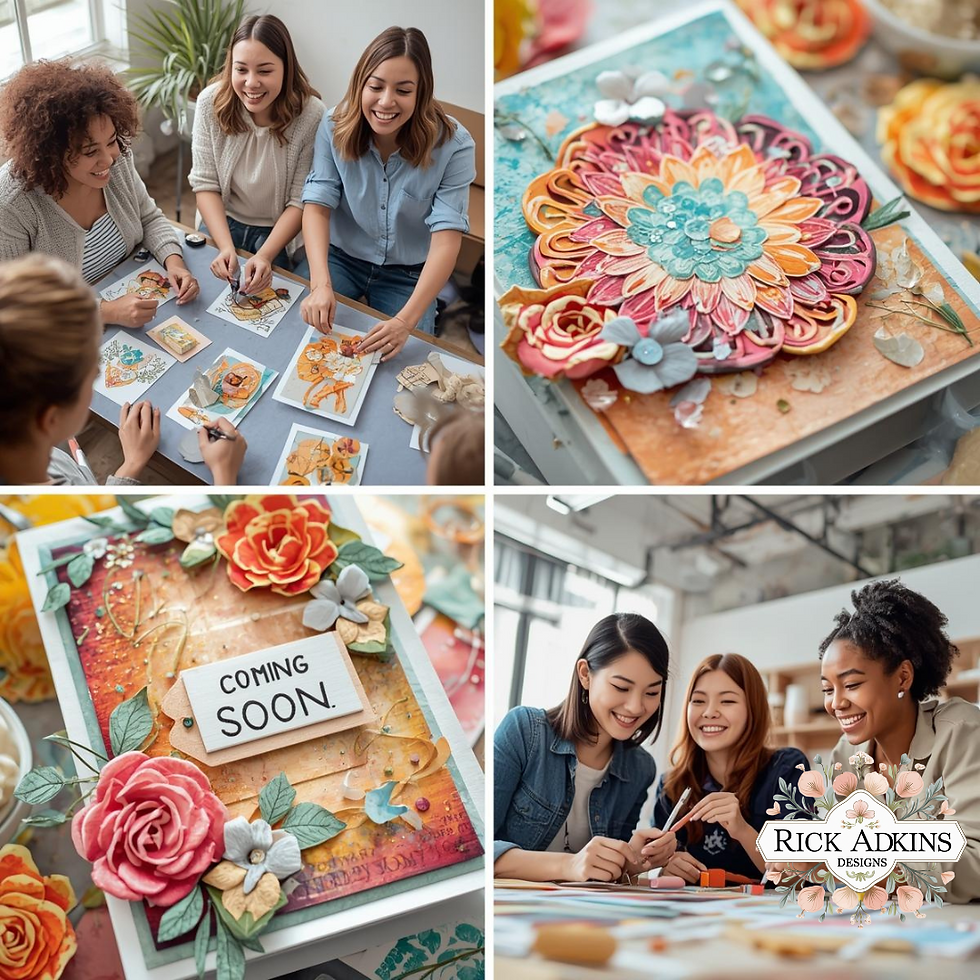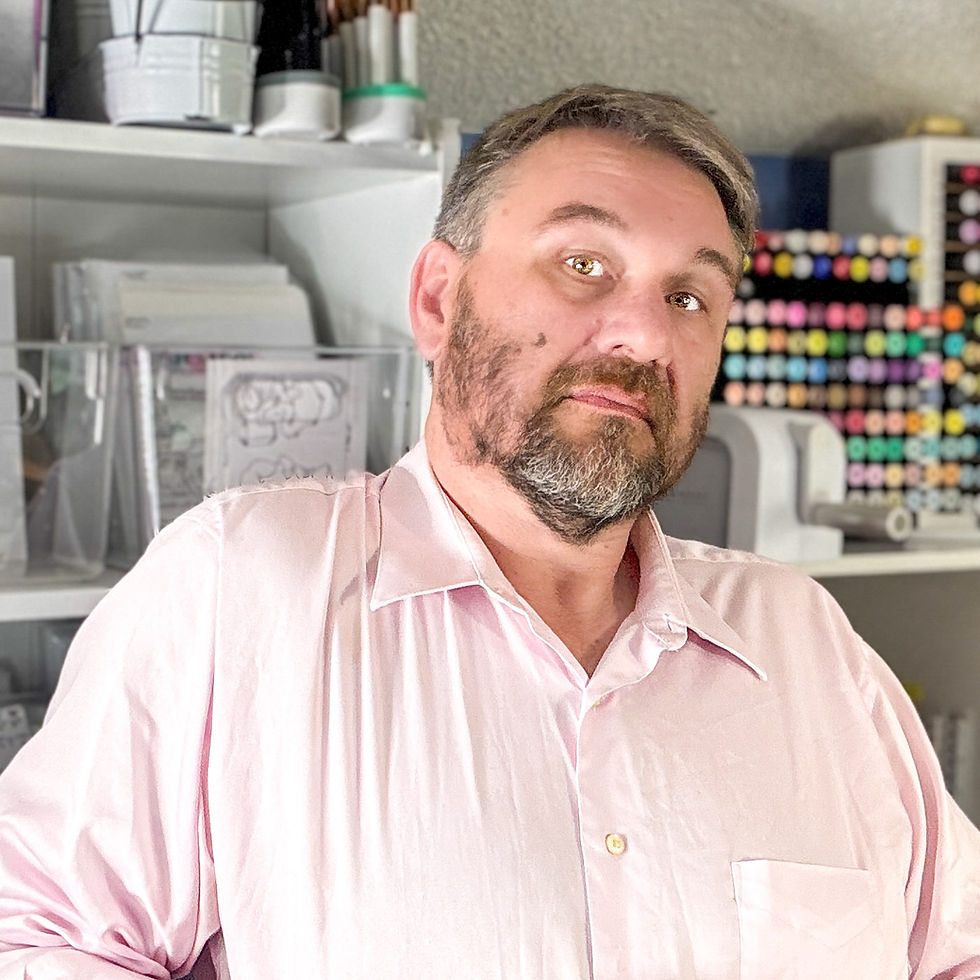Design Team Boot Camp: Insider Tips from Company Owners & Coordinators
- Rick Adkins

- Sep 9
- 5 min read
Updated: Sep 13
When I first started applying for design teams, I remember wondering: What are they really looking for? I’d spend hours second-guessing my projects, stressing over whether my follower count was high enough, or worrying if my style fit. If you’ve ever been there too, this post is for you. For the final part of my Design Team Boot Camp Series, I went straight to the source — I polled paper crafting company owners and DT coordinators and asked them to share what makes an application stand out, why they sometimes say no, and what helps team members thrive once they’re on board. Their answers were eye-opening, encouraging, and packed with wisdom.
Let’s dive into what they had to say!

Design Team Boot Camp: Insider Tips from Company Owners & Coordinators
What Companies Look for Most
Every single coordinator I spoke with mentioned the quality of your projects and photos. One company put it bluntly: “Good photography and editing. Without it, marketing is affected.” Another said, “We look for DT members that can create inspiring projects with our products — at all levels of expertise.”
This means you don’t have to be the most advanced crafter out there. What matters most is that your projects are well-made, beautifully presented, and show off the products clearly. Clean, bright photos are non-negotiable. If your photos are dark or blurry, it doesn’t matter how great the card is — the impact is lost.
Pro Tip: Before submitting an application, take the time to photograph your projects in natural light or with a basic light box. Editing tools like Snapseed or Lightroom can make a huge difference in polishing your photos.

Common Reasons Applicants Are Rejected
This is the part none of us like to think about, but it’s so helpful to know. Coordinators listed their top reasons for passing on applications:
Poor or inconsistent photography.
Not following directions. (Yes — something as simple as missing a detail on the application can get you disqualified!)
Projects that don’t fit the company’s style.
Association with knock-off companies like Temu or AliExpress.
Being stretched too thin across multiple teams.
One coordinator shared: “Doesn’t provide enough information or project examples to illustrate their abilities and understanding of our products.” Another noted, “Poor coloring skills, poor photographs of projects, not enough social media followers.”
Pro Tip: Don’t rush your application. Double-check you’ve answered everything, provide strong samples, and be sure your projects line up with the company’s aesthetic.

How Important is Social Media?
This was one of the most debated questions, but the majority agreed: social media matters. Some companies described it as “essential,” while others called it “somewhat important,” but everyone agreed that it’s not just about numbers — it’s about engagement.
One company explained: “Follower count is not necessary, but regular content a couple times per week is.” Another shared, “A positive presence is more important than the number of followers. Their social media presence can’t be a liability to the company.”
Across the board, the most valued platforms were Instagram, Facebook, YouTube, and Pinterest. Reels and YouTube Shorts came up repeatedly as some of the most effective ways to get eyes on products right now.
Pro Tip: Don’t worry if you don’t have thousands of followers. Instead, focus on posting consistently, engaging with your audience, and keeping your social feed professional, positive, and inspiring.

Expectations Around Products and Projects
Most companies expect 2–4 projects per month, though a few ask for more (sometimes up to 10!). In exchange, most send product valued between $50 and $100 monthly, sometimes more.
How much freedom you have in choosing products varies: some assign items, especially new releases, while others allow “designer’s choice.” I loved this perspective from one company: “We assign one project to support our new or best-selling product releases, and one that’s Designer’s Choice. This fosters more of a creative partnership.”
As for using other products, most companies want their products front and center. Some are strict about exclusivity, while others are more flexible as long as their brand is the “star of the show.”
Pro Tip: When you’re on a team, think of your projects as part of the company’s marketing. Your creativity shines brightest when it helps spotlight their products in the best possible way.

What Coordinators Value Most in Team Members
This was one of my favorite parts of the survey because it really highlighted that being on a design team is about more than just pretty cards.
Reliability and meeting deadlines.
A positive, team-focused attitude.
Clear communication.
Excitement about the products.
Flexibility to try new content formats.
One coordinator summed it up beautifully: “I most value the team members that collaborate with me in their monthly assignments, respond quickly, and are supportive of our initiatives and fellow DT members.”
How Success is Measured
Success isn’t only about numbers. Yes, companies track things like affiliate sales, website traffic, and social media analytics, but many coordinators mentioned something deeper:
Inspiring customers to recreate projects.
Generating excitement for new releases.
Showing consistent enthusiasm and professionalism.
As one explained: “If you post a project and all of a sudden I start receiving orders for the items used, that’s a success! Or if you inspire a customer to use what they have to recreate what you’ve done.”

One Piece of Advice from the Pros
To wrap things up, I asked coordinators for their single best piece of advice for applicants. Here are a few of my favorites:
“Be a partner in the Design Team process — thoroughly read the application and submission requirements.”
“Take well-lit, clean and crisp photos. Read the directions and answer all questions on the application.”
“Look at the company’s product style and make sure you have projects that reflect that style in your body of work.”
“Don’t get discouraged if not chosen. Apply to companies that play to your strengths.”
Final Thoughts
Reading through these responses, I was struck by how much heart company owners and coordinators put into their teams. They aren’t just looking for content machines — they’re looking for partners. People who will love their products, share them with joy, and help customers feel inspired.
So if you’ve been nervous about applying, take this as encouragement. Focus on your photography, be consistent on social media, create projects that reflect your style, and most importantly, apply to companies whose products you truly enjoy. That excitement will shine through every time.
This wraps up the Design Team Boot Camp Series, and I hope it’s given you both practical tools and the confidence to chase your dream team spot. And remember — the right team for you will value exactly what you bring to the table.
Thanks for dropping by today I hope that you found a little spark of creative inspiration from today's post.
Happy Crafting,

Rick Adkins
Affiliate Disclaimer:
Just a friendly reminder, as part of my commitment to transparency, please note that some of the links provided maybe affiliate links. This means that if you make a purchase through these links, I may earn a small commission at no extra cost to you. Your support is truly appreciated!
Additionally, I kindly ask that you always accept the tracking cookie for the affiliate websites. Rest assured, this will not in any way expose your computer to viruses or compromise your information. It's simply necessary for the company to attribute the sale to the affiliate, ensuring creators like myself receive their rightful commissions.
Your trust and support enable me to continue sharing creativity through my email lists, blog, and YouTube channel. Thank you for being a valued part of our crafting community!




Love this series.
I have loved this series!